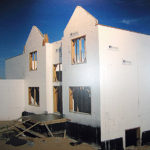The effect of thermal mass

Insulated concrete forms create massive insulated walls and save concrete too.
The insulation in your home’s ceiling, walls, and floor helps to slow heat movement, keeping your home warmer in the winter and cooler in the summer. Exterior and interior thermal mass walls have an averaging effect on the indoor temperature as the outdoor temperature varies. Heat accumulates in the mass during the day. Night temperatures and the cold night sky siphons off heat at night. This back-and-forth heat flow through a massive material is a slow process because it takes time to heat or cool the mass. That delay in heat flow subjects the indoors to the average outdoor temperature rather than the outdoor temperature extremes. Heavy masonry walls without insulation can maintain a temperature of around 70 degrees even as the hourly temperature fluctuates between 50 degrees and 90 degrees without any indoor space conditioning.
Thermal mass plus insulation
Insulation, on the other hand, resists or limits the rate of heat flow. The R-value of insulation describes only a wall’s resistance to heat flow. Insulated mass results in a higher-than-expected R-value for the combination of mass and insulation. When you insulate the massive wall on the exterior, you both reduce heat flow and exploit the averaging effect of the mass.
Research on insulated thermal mass walls
Studies performed by the Oak Ridge National Laboratory have confirmed the effect that massive walls have on home energy consumption. These studies show a “mass effect” for walls that increases the effective R-value of a home’s walls by a factor of 1.2 to 2.1 times. This improves the effectiveness of a heavy concrete or brick wall that measures R-11 to an effective rating of between R-15 and R-22. It’s not a large difference, and it’s still a good idea to install as much insulation as you can afford in your home. This mass factor could figure in when architects or builders design the homes of the future or recommend insulation retrofits for massive homes.
Best for warm climates
High thermal mass walls are most effective in warm climates where the outdoor temperature varies widely between day and night. The best way to employ thermal mass is to maximize the surface area of the thermal mass facing the interior of a home. Do this by making the interior walls massive in addition to the exterior walls. The right combination of insulation to slow heat flow, and thermal mass to moderate temperature variations, can create a home that is both energy efficient and comfortable.
Insulated concrete forms may be the most practical way of combining insulation and thermal mass in new homes.
For more information
Saturn’s book Residential Energy: Cost Savings and Comfort for Existing Buildings summarizes ORNL research on insulation and thermal mass in Appendix 6. Also, visit the Oak Ridge National Laboratory’s Building Technology Center.
What do you think?
Do you have experience with thermal mass walls? How were they constructed? Did they provide a more comfortable living environment? Post a comment below.
